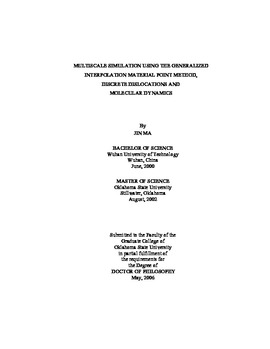| dc.contributor.advisor | Lu, Hongbing | |
| dc.contributor.author | Ma, Jin | |
| dc.date.accessioned | 2013-12-10T18:05:19Z | |
| dc.date.available | 2013-12-10T18:05:19Z | |
| dc.date.issued | 2006-05 | |
| dc.identifier.uri | https://hdl.handle.net/11244/7807 | |
| dc.description.abstract | Scope and Method of Study: A multiscale simulation scheme that spans the atomistic scale to the continuum has been developed for materials simulations in this study. At the continuum scale, the generalized interpolation material point (GIMP) method has been extended for parallel processing using the Structured Adaptive Mesh Refinement Application Infrastructure (SAMRAI). A contact algorithm in GIMP has been developed for the treatment of contact pair between a rigid indenter and a deformable work piece. Two spatial refinement schemes for GIMP are presented for simulations with highly localized stress gradients at the continuum scale. A method for multiscale simulation bridging different scales, namely the continuum scale using GIMP, the mesoscale using discrete dislocations and the atomistic scale using the molecular dynamics (MD), is presented and validated in two dimensions. | |
| dc.description.abstract | Findings and Conclusions: Numerical simulations with multiple length scales from nanometer to millimeter were conducted and validated on a 2D nanoindentation problem. Numerical simulations of several problems, such as tension, indentation, stress concentration and stress distribution near a crack (mode I crack problem) are presented to validate the refinement schemes at the continuum scale as well as the parallel processing algorithm. The capability of handling large deformation in GIMP is also demonstrated. A mode I crack propagation problem is simulated using the coupling algorithm. The stress field near the crack tip was validated by comparing results from coupled simulations with purely GIMP simulations of the same model. Coupled simulation results were also compared with purely MD simulations. A very good agreement was obtained. Other problems, such as dynamic friction problem at atomistic scale and the nanoindentation problem, are also simulated using the multiscale simulation algorithm. | |
| dc.format | application/pdf | |
| dc.language | en_US | |
| dc.rights | Copyright is held by the author who has granted the Oklahoma State University Library the non-exclusive right to share this material in its institutional repository. Contact Digital Library Services at lib-dls@okstate.edu or 405-744-9161 for the permission policy on the use, reproduction or distribution of this material. | |
| dc.title | Multiscale simulation using the generalized interpolation material point method, discrete dislocations and molecular dynamics | |
| dc.contributor.committeeMember | Komanduri, Ranga | |
| dc.contributor.committeeMember | Hanan, Jay C. | |
| dc.contributor.committeeMember | Coker, Demirkan | |
| dc.contributor.committeeMember | Raff, Lionel M. | |
| osu.filename | Ma_okstate_0664D_1823.pdf | |
| osu.accesstype | Open Access | |
| dc.type.genre | Dissertation | |
| dc.type.material | Text | |
| thesis.degree.discipline | Mechanical Engineering | |
| thesis.degree.grantor | Oklahoma State University | |
